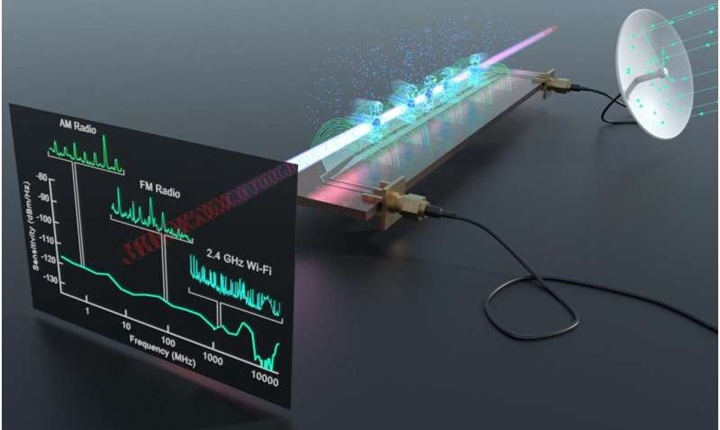The Future of Telecommunications: From FR1 to THz with Quantum Sensors
Historically, terrestrial telecommunication systems have operated in frequency bands below 6 GHz due to their balance between coverage, capacity, and indoor penetration, with some exceptions for WiFi systems. However, these bands, known as FR1, are now saturated. Additionally, they do not allow for the high bandwidths required by future services such as extended reality (XR) or volumetric video. This has driven research and development of terrestrial communication systems in higher frequency bands, such as FR2 (24-52 GHz and 57-71 GHz), FR3 (7-24 GHz), high millimeter-wave/sub-THz (92-114.25 GHz and 130-174.8 GHz), and THz (0.3-10 THz).
Key Challenges of High-Frequency Usage
One of the key aspects of using high frequencies is ensuring that equipment and devices remain cost-effective and energy-efficient. One way to achieve this is through the design of systems based on commercial off-the-shelf (COTS) components rather than more expensive telecommunications equipment from manufacturers, which do not allow for customization of specifications such as transmission and reception frequencies. Additionally, high frequencies are highly sensitive to distance, making it essential to develop techniques that enhance coverage.
Multi-Band Integration: Highly Tunable Quantum Sensors
The availability of multiple communication bands presents the challenge of integration—ensuring that a single system can use, for instance, both FR1 and sub-THz, despite hardware component incompatibilities. Quantum sensing technology, based on tuning RF bands to the atomic spectrum of Rydberg states, enables the development of multi-band sensors. These sensors, on a single hardware platform, can detect signals across a broad spectral range—from FR1 to THz frequencies—overcoming hardware limitations. Moreover, they offer extreme sensitivity for detecting low-intensity signals, paving the way for high-performance multi-channel optical detection applications.
Advances in Radio Frequency: Efficient Front Ends and Enhanced Coverage
In mobile communication networks, a cell’s energy efficiency is directly related to the power amplification stages in its radio front end. However, the most efficient power stages suffer from linearity issues, which negatively affect cellular multi-carrier signals. Linearizing the transmission stages alleviates the requirements for power amplifiers, but implementing these techniques presents a significant challenge in scenarios with multi-antenna systems and large bandwidths, which are common in millimeter-wave (mmWave) frequencies.
The technology used in power amplifiers affects both efficiency and cost in experimental radio front ends, a problem that worsens at mmWave frequencies. Alternative implementations of radio front ends for sub-6 GHz and mmWave bands are difficult to miniaturize in multi-antenna systems and offer low energy efficiency. The 6GDIFERENTE project designs and develops compact multi-antenna radio front-end prototypes capable of adaptive digital pre-distortion, achieving higher energy efficiency than generic connectorized elements. Additionally, research is being conducted on mechanisms for coverage extension with multi-band application, allowing for use in both THz and mmWave bands.
Coverage Enhancement Techniques for High-Frequency Bands
In lower telecom bands such as FR1, the assigned bandwidth rarely exceeds tens of MHz, posing a significant hurdle for ultra-broadband services like XR. High-frequency bands allow access to bandwidths of several GHz but suffer from limited coverage due to signal propagation losses. Specifically, at THz frequencies, the path loss in a 10-meter link can exceed 100 dB, making long-distance communication difficult. Additionally, transmission power at these frequencies is highly constrained.
To mitigate this issue without increasing transmission power, signal processing techniques can be employed to extend range. One such technique reduces phase noise at the receiver, resulting in a clearer signal and enabling longer communication distances without compromising quality. Additionally, various methods exist for transmitting the OFDM signal, used in 5G and anticipated in future 6G networks, known as numerologies. Numerology determines the bandwidth of OFDM carriers, which is 15 kHz in LTE (4G) and 15/30/60/120/240 kHz in 5G. Millimeter waves use 120 kHz and 240 kHz due to the need for higher bandwidths and frequencies. Higher numerologies reduce interference between OFDM carriers, improving coverage.
Quantum RF Sensors: Introduction to Quantum Sensing
Throughout the 20th and 21st centuries, quantum technologies have advanced significantly, reaching commercialization in fields such as telecommunications (notably quantum key distribution, or QKD) and quantum sensing.
What Are the Components of a Quantum RF Sensor?
A quantum RF sensor consists of a glass container filled with a diluted gas of atomic elements, typically an alkali metal such as rubidium, cesium, or potassium. A pump laser excites the gas to a higher energy state. Then, an excitation laser further boosts the atoms to very high energy levels, known as Rydberg states. In these states, radiofrequency waves can interact with the electrons, allowing them to absorb energy from the external radio spectrum. This process impacts the amount of light the atoms absorb from the pump laser, enabling precise monitoring and measurement of external radiofrequency signals via an optical photon detector.
Advantages of Quantum Sensors
In telecommunications, quantum sensors offer several advantages over traditional antennas:
- Size, Weight, and Power Consumption (SWaP): A quantum RF sensor is roughly the size of a large box, occupying a volume of approximately 0.125 m³. In contrast, most telecommunications antennas are between 5 and 15 meters tall, making the size reduction significant. A smaller size means less material usage and weight. Additionally, these sensors require fewer components and consume an amount of energy comparable to that of a mid-range desktop computer—much lower than that of traditional antennas.
- Resilience to Electronic Attacks: Being more resistant to electronic attacks than conventional antennas, quantum RF sensors can be employed in both civilian and military environments, as well as dual-use settings where both coexist.
Authors: José Joaquín Escudero, Head of Mobile Communications; Andrés Ulibarrena, Senior Research Engineer at Gradiant; Marta Castro, Head of Micro-Nanoelectronics and Photonics; and Miguel Ferreira, Head of Quantum Technologies. They all belong to Gradiant’s Advanced Communications area.
6GDIFERENTE is a project funded by CDTI under the CERVERA program.

